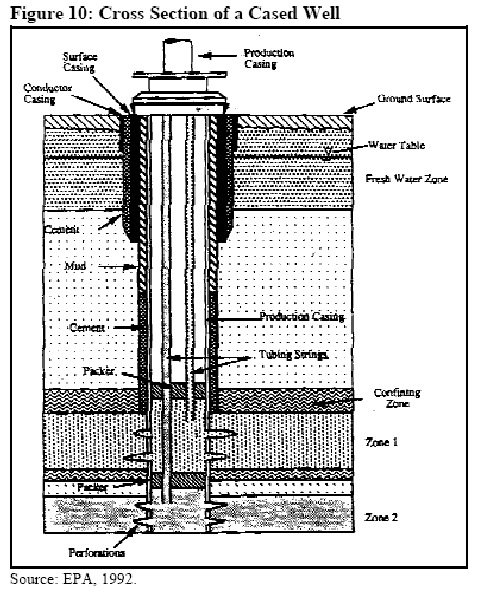
- •Федеральное агентство по образованию
- •Contents
- •Предисловие
- •Unit 1 oil exploration Text 1
- •Industrial Processes in the Oil and Gas Extraction Industry
- •Text 3 Oil and Gas Exploration
- •Text 4 Where to Look for Fields?
- •Ex.2 Put down the words in bold from the text in your notebook and try to explain their meanings to your fellow-students keeping the text covered.
- •Text 7 Seismic Exploration
- •Text 8 Onshore and Offshore Seismology
- •Figure 1.
- •Figure 2.
- •Text 9 Magnetometers and Gravimeters
- •Data Interpretation
- •Text 11 Exploratory Wells
- •Figure 3.
- •Text 12 Logging
- •Crossword
- •Unit 2.
- •Well development
- •Drilling
- •Figure 4
- •Text 2 Drilling Fluids
- •Figure 5. The mud circulatory system
- •Text 3 Casing
- •Figure 6. Cross Section of a Cased Well
- •Figure 7. Text 4 Drilling Infrastructure
- •Onshore Drilling
- •Figure 7.
- •Figure 8 …. Engines, compound, and drawworks Offshore Drilling
- •Text 5 Well Completion
- •Unit 3.
- •Production
- •Production Equipment Installation
- •Text 2 Stages of Petroleum Production
- •Unit 4.
- •Well shut-in/well abandonment
- •Onshore Stoppage of Production
- •Text 2 Offshore Platform Decommissioning
- •Major oil and gas companies
- •Text 2 gazprom
- •Text 3 sibneft
- •Organizational Structure
- •Text 4 yukos
- •Text 5 rosneft
- •Text 6 surgutneftegas
- •Text 7 tnk-bp
- •Oil and gas companies quiz
- •References
Text 3 Casing
water bearing - водоносный (пласт, порода, горизонт), содержащий воду
hydrocarbon bearing- содержащий углеводороды
“onductor” casing - направляющая обсадная колонна
commencement n - начало, ввод в разработку, дата забуривания новой скважины
pile driver - свайный молот, сваебойный молот
“surface” casing - кондукторная обсадная колонна, кондуктор (первая обсадная колонна), первая технологическая колонна
aquifer n - водоносная зона
incursion n - просачивание, вторжение
brine n - соляной раствор из скважины, рассол
“intermediate” string - промежуточная колонна труб
facilitate v - облегчать; способствовать; облегчить
logging tool - скважинный зонд (для каротажа), каротажный прибор, каротажное устройство
“production” string - эксплуатационная колонна, насосно-компрессорная колонна
downhole a - внутрискважинный, подземный, погружной, забойный
tubing string - колонна напорно-компрессорных труб
perforation n - перфорационное отверстие, перфорационный канал (в пласте), перфорированный интервал (в скважине)
packer n - пакер (устройство для разобщения отдельных зон в скважинах), гидравлическая манжета
reservoir fluid - пластовый флюид
plug n - штекер, пробка-вертлюг, цементировочная пробка
producing zone - продуктивная зона, продуктивный интервал (в скважине)
leak v – просачиваться, протекать
sediment n – осадок, нанос, отложение
As
the hole is drilled, casing is placed in the well to stabilize the
hole and prevent caving. The casing also isolates water bearing and
hydrocarbon bearing zones. As shown in Figure 10, three or four
separate casing “strings” (lengths of tubing of a given diameter)
may be used in intermediate-depth wells. In locations where surface
soils may cave in during drilling, a “conductor” casing may be
placed at the surface, extending only twenty to one hundred feet from
the surface. This string is

Figure 6. Cross Section of a Cased Well
often placed prior to the commencement of drilling with a pile driver.
The next string, or “surface” casing, begins at the surface and may penetrate two thousand to three thousand feet. Its primary purpose is to protect the surrounding fresh-water aquifer(s) from the incursion of oil or brine from greater depths. The “intermediate” string begins at the surface and ends within a couple thousand feet of the bottom of the wellbore. This section prevents the hole from caving in and facilitates the movement of equipment used in the hole, e.g., drill strings and logging tools. The final “production” string extends the full length of the wellbore and encases the downhole production equipment. Shallow wells may have only two casing strings, and deeper wells may have multiple intermediate casings. After each casing string has been installed, cement is forced out through the bottom of the casing up the annulus to hold it in place and surface casing is cemented to the surface.
Casing is cemented to prevent migration of fluids behind the casing and to prevent communication of higher pressure productive formations with lower pressure non-productive formations. Additional features and equipment will be installed during the completion process for production: perforations will allow reservoir fluid to enter the wellbore; tubing strings will carry the fluid to the surface; and packers (removable plugs) may be installed to isolate producing zones.
Casing is important for both the drilling and production phases of operation, and must therefore be designed properly. It prevents natural gas, oil, and associated brine from leaking out into the surrounding fresh-water aquifer(s), limits sediment from entering the wellbore, and facilitates the movement of equipment up and down the hole. Several considerations are involved in planning the casing. First, the bottom of the wellbore must be large enough to accommodate any pumping equipment that will be needed either upon commencement of pumping, or in the later years of production. Also, unusually pressurized zones will require thicker casing in that immediate area.
Any casing strings that must fit within this string must then be smaller, but must still accommodate the downhole equipment. Finally, the driller is encouraged to keep the hole size to a minimum; as size increases, so does cost and waste.

